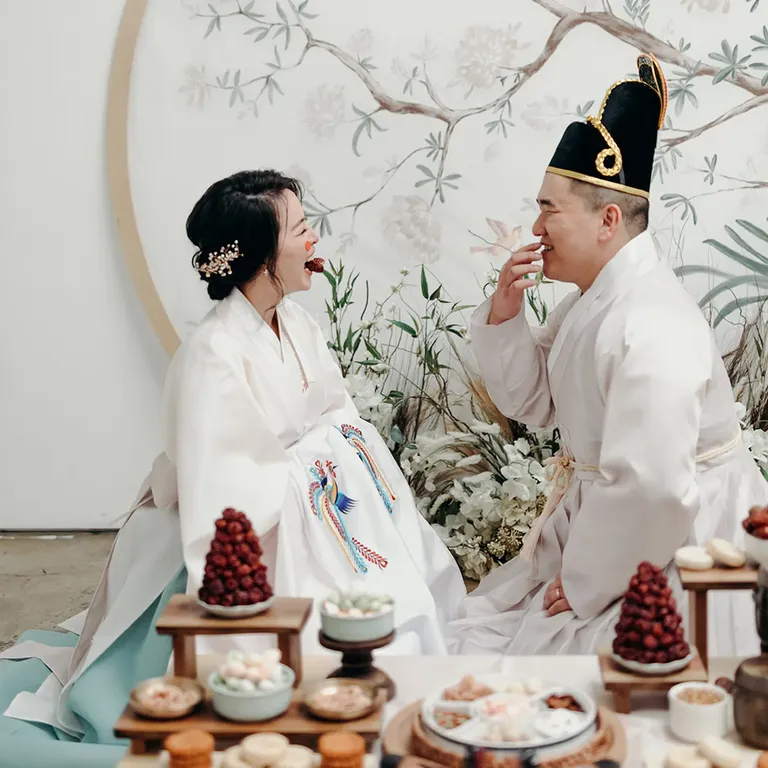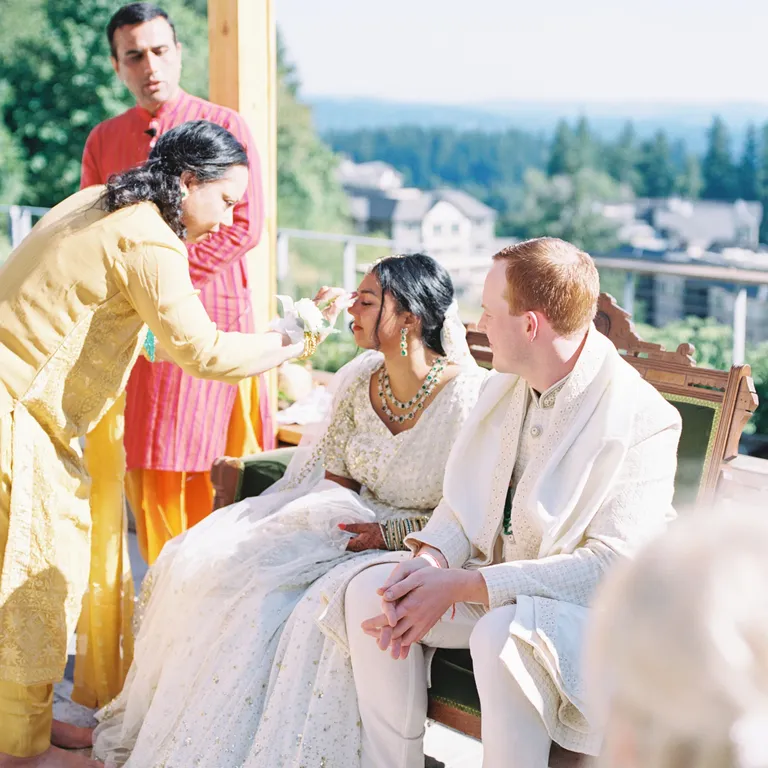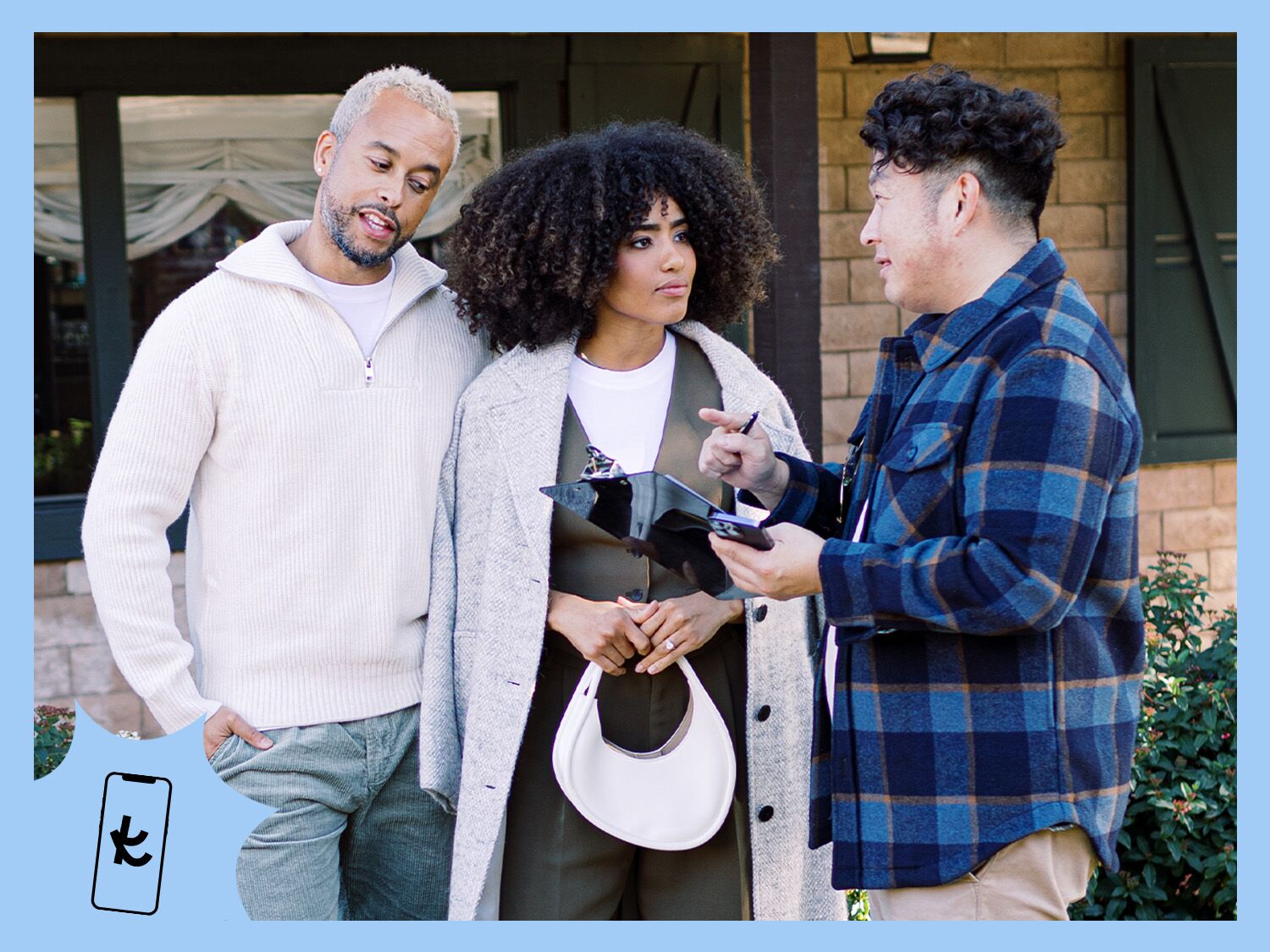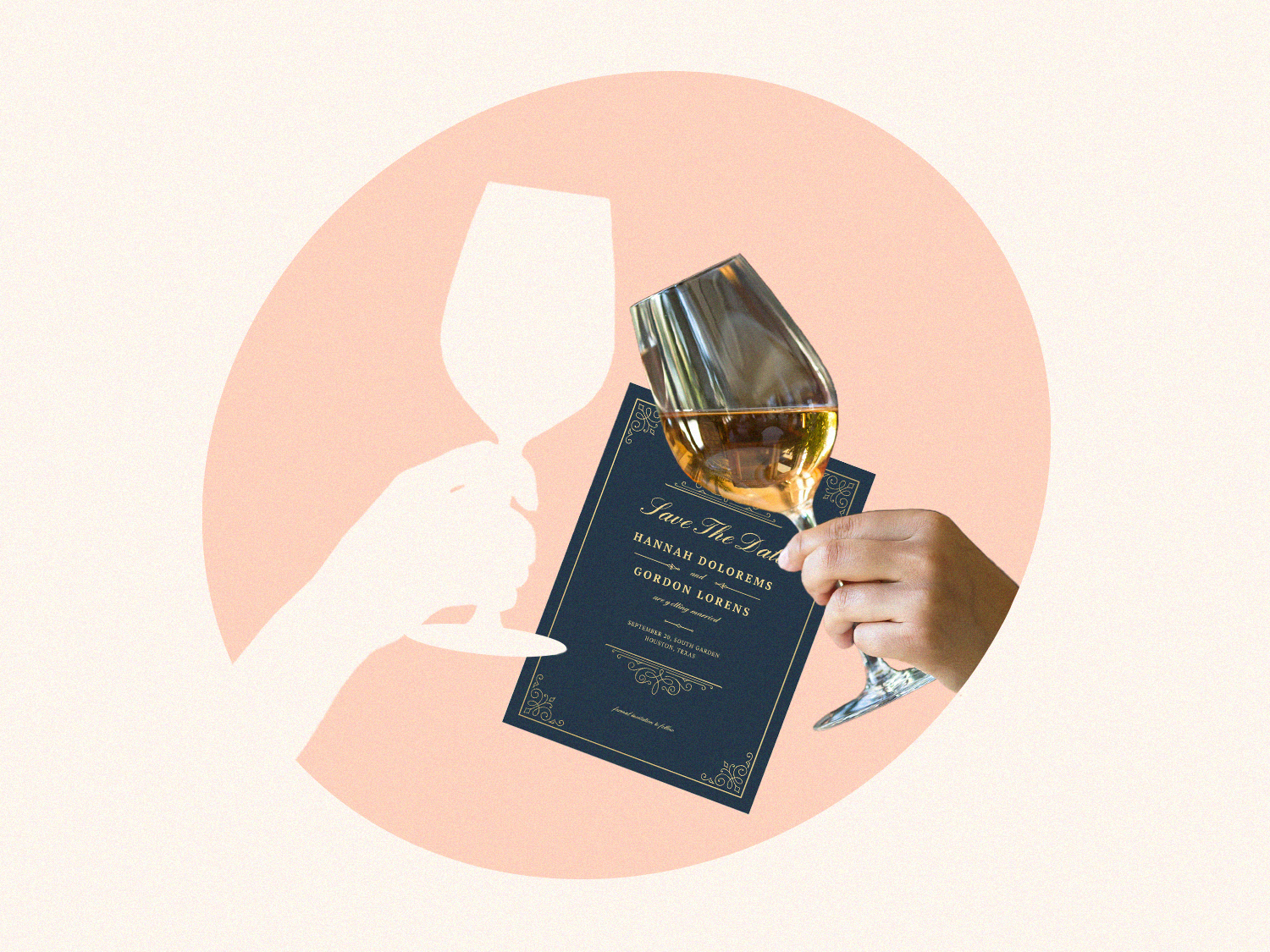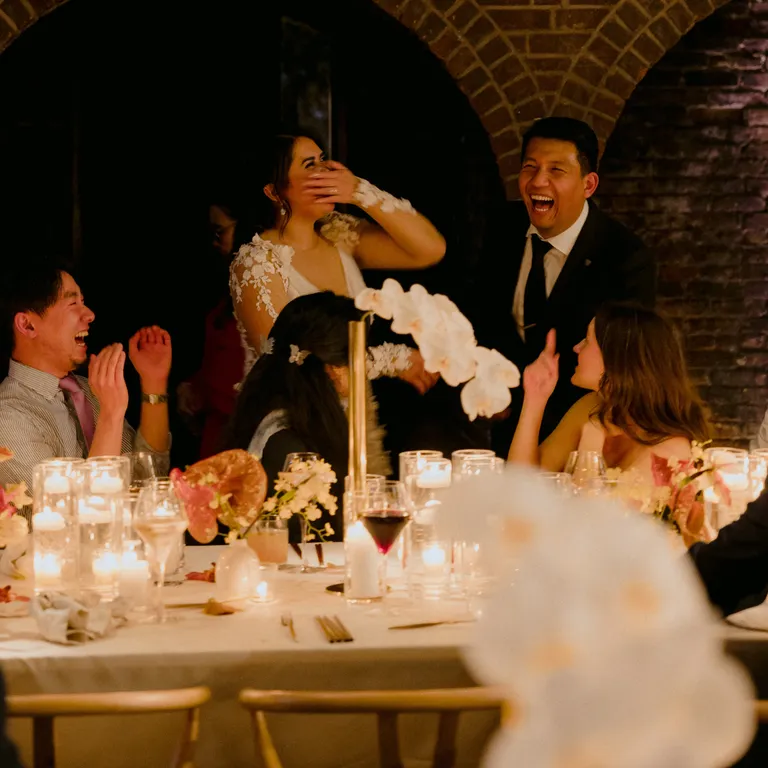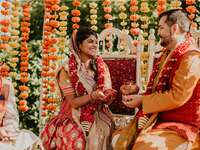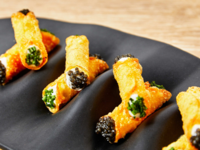Not a Matrimonial Monolith: Celebrating Diversity Among Asian Weddings

Glance at a wedding and you'll see two people in love, committing to a life together. Look longer and you'll notice the rich tapestry of traditions that unfurls around them, embracing the pair like loving arms from generations of family members. Honoring one's heritage is implicit in nuptials, and while it's true that Asian weddings are often culture-rich, it's both inaccurate and harmful to categorize them as a monolith. Just as there is no one way to identify as AAPI, there is no one-size-fits-all format to an Asian wedding ceremony. We tapped a slate of esteemed AAPI wedding professionals to illuminate the complexities between Asian wedding traditions and how we can all honor these exceptional events—rooted in 50+ distinct countries and cultures—with the sincerity and accuracy they deserve. Because, as wedding editors, we know that we can learn so much about one another in the unique ways we gather, celebrate and unite in love.
In this article:
Our Experts | Culture & Community | Cultural Nuances | How We Can Learn | AAPI Heritages
Our Panel of Experts
These celebrated pros dig deep into why noticing nuances and cultural complexities is paramount to honoring the AAPI community.
- Christina Kim Mathis: Also the owner/chef behind Washington-based Blue Box Bakery, where she concocts stunning wedding cakes, 2023 The Knot Ones to Watch honoree Christina Kim Mathis co-owns Seattle Korean Weddings with her mother, Chong Kim, which supplies Korean couples in the area with the hard-to-find trappings of the traditional Paebaek ceremony.
- Sneh Diwan: Sneh Diwan is the creative eye behind boutique wedding and events company Diwan By Design. While Diwan By Design has been planning South Asian weddings from its conception, the company also plans all kinds of multicultural weddings, helping clients find the perfect balance of cultures and family traditions.
- Diana Lin: Founder and Creative Director of Cóllectives by Diana, Diana Lin is an expert in event and wedding planning, design and interior styling, which allows her to craft immersive experiences that resonate with each couple's unique love story.
- Xiaoqi Li: Xiaoqi Li is the owner and lead photographer of the Charlottesville, VA-based Xiaoqi Li Photography. She is most recognized for her candid storytelling and timeless style as well as creating an inclusive space for all couples.
- Jennifer Qiao and Vivian Chan: Jennifer Qiao and Vivian Chan are the co-founders of East Meets Dress—the first modern fashion company that offers stylish, traditional wedding wear for Chinese and Vietnamese weddings.

What Wedding Traditions Mean for a Culture and Community
Even when surrounded by modern practices and personalized elements, a wedding tradition never exists in a vacuum. Customs across Asian weddings today stem from numerous heritages and historical roots. For many AAPI couples, plucking one or many traditions to weave into their weddings is deeply personal—a testament to how their distinct culture and experiences have shaped their lives and love.
Representations of Values and History
Wedding planner Diana Lin incorporated a Chinese tea ceremony into her own nuptials. "It was not just about following a cultural custom; it was about honoring our heritage, paying respect to our parents, and symbolizing the union of our families," says Lin, who notes that the auspicious practice creates a profound connection between generations as the couple demonstrates their commitment to upholding familial values and traditions. "Moreover, the tea ceremony allowed us to share this cherished tradition with our friends and relatives, many of whom may not have experienced it before. It provided a glimpse into our cultural identity and allowed them to be a part of something meaningful and authentic to us."
While it also showcases the importance of honoring your parents and welcoming a new spouse into the family, a significant aspect of the Korean paebaek ceremony—a traditional bowing ritual—also focuses on elders showering blessings and prosperity on the couple in the form of dates and chestnuts. The couple holds a stretch of fabric between them as the treats are tossed toward them—the number of dates and chestnuts that land on the fabric supposedly indicate how many children the couple will have. Seattle Korean Weddings co-owner Christina Kim Mathis, who would have five girls and four boys if the predictions from this "fun and lighthearted tradition" came true, underscores the hunger that couples have to incorporate Korean wedding practices like the paebaek ceremony into their special days, which became evident when she established Seattle Korean Weddings a few years after she got married in 2014. "I did absolutely zero advertising for it, and neglected to even tell some of my close wedding vendor friends about it—and booked all my rentals via random search engine traffic," says Kim Mathis. "It's only been within the last year or two that I've realized how many bookings I was receiving without any effort and how there is a growing interest in including this cultural element into the wedding day."
A popular prewedding ritual at many Indian weddings, the haldi (also known as pithi, tel baan, gaye holud, ubtan or mandha in different regions of India) showcases the importance of a couple's closest community of loved ones in the marriage process, offering space for them to give advice and well-wishes the day or morning before the nuptials. "This tradition first begins with a short prayer to bless the couple, followed by family and friends all taking turns covering the couple with a turmeric paste (often mixed with yogurt, cream or rose water), which is said to brighten and exfoliate your skin, so you look fresh and ready for your wedding day," says wedding planner Sneh Diwan. "The application of the paste generally begins with the matriarchs of the families gently placing the paste on the couple, and escalates to a fun mess by the time friends of the bride and groom get their turn."
Vivian Chan and Jennifer Qiao, co-founders of East Meets Dress, note that wedding attire can also indicate what values a culture holds dear. "In Chinese culture, red is the predominant color for weddings, symbolizing happiness and good fortune. On the other hand, Vietnamese brides wear a variety of colors, including red, pink, white and pastels, to symbolize luck, romance, femininity and innocence," say Chan and Qiao. The embroidery and motifs adorning the wedding attire also carry different symbolism between Chinese and Vietnamese cultures. "Chinese embroidery often includes the phoenix or dragon, which represent the bride and groom, and symbolize happiness, longevity and prosperity for the couple. Meanwhile, Vietnamese embroidery may feature motifs inspired by nature and folklore."
The duo also mentions that, in addition to wearing traditional wedding outfits, their Chinese-American couples love incorporating traditional foods, such as abalone and sea cucumber in their dinner. "In Mandarin, the word for abalone sounds like the word for abundance, while the Cantonese word for sea cucumber sounds like the word for good heart so these two combined provide good luck for their future marriage," they say. "Meanwhile, Vietnamese weddings typically serve pork and sticky rice, because the red color and stickiness of the foods ensure the couple stays together. By experiencing these weddings, wedding guests can also get a taste of the richness of the broader culture that the couple is a part of."
From Filipino wedding customs that often blend Catholic and indigenous practices, to binding rituals like the Japanese san-san-kudo, these wedding traditions are just as varied as the Asian-identifying and multicultural couples who choose to use them. It's clear that these marital traditions showcase what values are the heart and soul of each AAPI group.
Reflection of the Individuality of AAPI Couples
Incorporating long-held cultural customs into their weddings can feel like a homecoming for many American couples hosting Asian wedding ceremonies, taking a moment to acknowledge, honor and sometimes even learn more about their backgrounds. But every wedding—even those leaning heavily into one culture—will uniquely reflect the two individuals celebrating their union. "I love the richness of multicultural weddings," says photographer Xiaoqi Li. "I'm familiar with many AAPI cultural ceremonies, from tea ceremonies and door games to baraats and performances such as the Uzbek knife dance. Even within cultures, these traditions can vary from family to family, so I'm always sure to get to know my couple's specific plans."
The East Meets Dress co-founders mention that special wedding outfit customizations that play on tradition, but ultimately are reflections of the partner or couple are some of the most rewarding projects of their work. "We've helped a variety of couples—from LGBTQIA+ couples, to multicultural couples, to adoptees who are looking to honor their heritage," say Chan and Qiao. "One bride asked to embroider a few Chinese characters on her qipao dress to say 'I love you.' Another bride sent us an old photograph of her mother's qipao wedding dress, and we custom made a similar version for her to wear at her own wedding tea ceremony as a surprise. It was such a beautiful way to honor and thank her parents for their hard work and sacrifices as immigrants."
While some couples might showcase their individuality by incorporating a long-held tradition in an unexpected way—like the Indian brides Diwan has seen opt for their own baraat, which is typically a procession for the groom filled with dancing as friends and family lead him to the mandap (altar)—others dig deep into their own personal narratives. One such couple resonated with Diana Lin, as their wedding day was a testament to how they navigated the intricate intersections of their Japanese and Chinese backgrounds within the context of post-colonial cultures. "Both grew up in or had connections to post-colonial cultures (Singapore and Japan)," says Lin. "The bride studied film and literature in college, delving deeply into the intersection of these fields. She was particularly interested in exploring post-colonialism and its manifestations in Asian film and literature. Additionally, she immersed herself in the jazz scene in Tokyo for two years after college, finding solace and a sense of belonging amidst the cultural shock of returning to her home country as an adult. I found her story to be relatable, and one that many others can likely relate to as well."
The wedding that resulted from this multifaceted pair blended traditional elements with a contemporary twist that mirrored their personal journey. "The serene elegance of the ceremony space, drawing from Zen and modern Japanese influences, stood in contrast to the vibrant energy of the outdoor reception, evoking the spirit of Asian night markets and festivals," continues Lin. "Their story serves as a reminder of the power of love to transcend boundaries and bring together diverse cultural backgrounds into a harmonious celebration of unity and shared experiences."
Honoring the Cultural Nuances Between AAPI Weddings
As aforementioned by our experts, the complexities found in all AAPI weddings embody not only the myriad cultures the acronym represents, but also the individual identities of each and every person and couple that identify with it. And the best way we can honor these cultures is to keep our minds, eyes, ears and hearts open to appreciate and understand their marriage traditions. But there's a deeper meaning behind acknowledging these traditions for some couples in the AAPI community. It's a celebration of diversity, a moment of unabashed pride for their resplendent heritages.
Why it Matters
There's something special about weddings where, more than any other time in your life, you're invited to embrace your most authentic self—and you know your loved ones will hug you back. According to Christina Kim Mathis, nuptials are an especially transformative time for many of the Korean couples she works with, and many second-generation Korean Americans are using the occasion to shine a light on the Korean aspect of their identity. "It's a common theme amongst my past couples and myself that we spent most of our lives trying to assimilate. We were often embarrassed when we went to school with our very Korean lunches or when our parents spoke to us in Korean in public—but now, we want to not only embrace it, but share our culture with our friends," says the pro. She also notes that, at her own wedding nine years ago, she regrets holding her paebaek ceremony behind closed doors (though it's customary for these rituals to be private to close family only)—but today, she's seeing most of these traditional rituals shared with the entire guest list. "I would say that 95% of the paebaek ceremonies I help with are being held in front of all the wedding guests, most of whom have never experienced a ceremony of this nature," says Kim Mathis. "At every ceremony, people not just of other cultures, but those of Korean heritage as well, come to me and say how wonderful it was to see something like this done so openly. And how beautiful and fun it is to see the culture celebrated."
Diwan seconds this notion, elaborating that every single region and community has its own distinct way of unifying a couple: "Learning the unique customs of weddings from a particular culture offers respect to the generations of families that had fought hard to keep their heritage alive even through the struggle between assimilation and sticking to tradition." Weddings are windows—windows to cultural understanding, heritage appreciation and, perhaps most importantly, inclusivity.
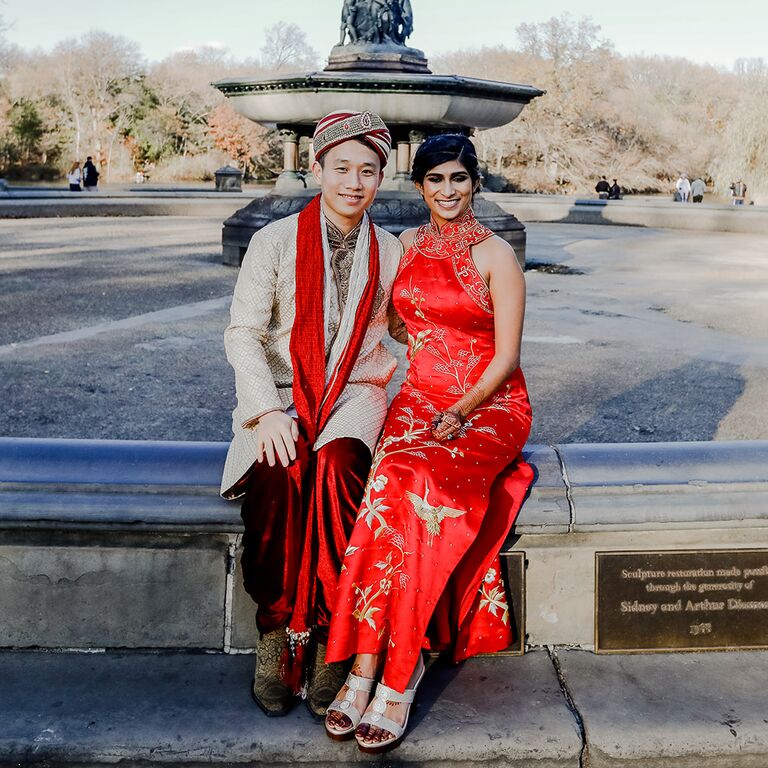
The Pitfall of Assumption
Assuming that all Asian people, cultures and weddings are the same is an exercise in erasure. "Highlighting the complexities and nuances between AAPI celebration styles promotes cultural awareness and sensitivity, avoiding cultural stereotyping and misrepresentation," says Lin. "Understanding the differences between AAPI celebration styles provides an opportunity for cross-cultural learning and exchange, fostering mutual respect, empathy and inclusivity in multicultural societies. Ultimately, by acknowledging and celebrating the differences between AAPI celebration styles, we can create a more inclusive and harmonious society where cultural diversity is valued, respected and celebrated."
Xiaoqi Li underscores that being subject to stereotyping is a pervasive issue among Asian Americans, and says that weddings, in particular, are great vehicles to showcase and celebrate one's heritage and identity: "Assuming that all AAPI weddings or even sub-sections of AAPI wedding cultures are the same erases the personal identities of these individual people and cultures. Distinguishing between cultures in the context of weddings contributes to the fight against stereotypes and overgeneralizations in everyday life. Acknowledging these differences, whether they're big or subtle, uplifts cultural diversity and shows respect."
How We Can Learn and Grow
Across our panel of pros, themes of mindfulness and thoughtful education came up time and time again. As respectful guests, engaged couples and as wedding industry professionals, our experts offered their advice on what we can all do to better foster education and understanding through AAPI weddings.
As Guests
Diana Lin notes that being a respectful and engaged guest at a Chinese wedding starts before the ceremony itself and continues. Here are her tips:
- Learn About the Traditions: Dedicate time ahead of the nuptials to research the meaning and significance of the traditions you might or will witness at the wedding to deepen your appreciation of the ceremony and its cultural nuances.
- Honor Customs and Manners: Pay attention to and respect the cultural norms and traditions. Take cues from the hosts and engage in ceremonies with the appropriate reverence and decorum.
- Choose Your Attire Wisely: Follow any specified dress codes and be mindful of color symbolism in your outfit choices. Red is auspicious and often welcomed, embodying luck and joy.
- Thoughtful Gifting: Opt for red envelopes as gifts, a cherished tradition symbolizing good fortune. Consider incorporating numbers like eight or nine, which are seen as particularly auspicious, while steering clear of four, which is associated with misfortune. Gifts to avoid include those with unintended negative meanings, such as clocks (symbolizing the passing of time), umbrellas (indicative of separation), pears (representing parting) and shoes (implying walking away).
Sneh Diwan notes that guests at Indian celebrations also should feel empowered to ask the couple or other guests for tips on what to wear, but still take the time themselves to uncover how best to appreciate the in-depth rituals that accompany traditional Indian Hindu weddings. "As a couple extends a wedding invitation to you, they are sharing the most intimate pieces of their love," says Diwan. "The least we can do as guests is take the time to understand how they celebrate their marriage as well as the significance it holds in their culture and for their families."
As Engaged Couples
If you're unsure how to incorporate a piece of you or your partner's heritage into your nuptials, Christina Kim Mathis says to chat with elders in your family or network. Their seasoned perspectives will help you glean a deeper understanding of the nuances between AAPI cultures, and how to pass them down to the next generation. "Specifically within the East Asian cultures, there are a lot of similarities between the celebration styles, but there are also a lot of differences," says Kim Mathis. "It can get confusing when these cultural differences get melded together because a lot of our histories and cultural significances in these particular traditions are passed down in an auditory manner. I personally found while trying to research the meanings and traditions behind Korean celebrations that not a lot of information was available in English, so I needed to ask my parents or grandparents about the cultural significance."
Kim Mathis mentions that many Korean couples she works with can even have misbeliefs at first. "The biggest misconception is that the paebaek ceremony is a tea ceremony. Most couples I speak with, this seems to be the biggest surprise to them," says the pro. "While there is a tea or soju component that can be added to the paebaek, the main purpose of the ceremony is bowing." But whether you opt to incorporate one tradition or five of them into your special day, weddings are a powerful impetus to learn more about your own heritage, if you choose.
Weddings As a Peek Into AAPI Heritages
When asked if they believe that weddings in particular are essential gateways to understanding the values, legacy and history of the varied heritages that encompass the AAPI label, all answered with resounding affirmation. "[A wedding] is such a welcoming, authentic way to participate in other cultures, oftentimes in ways people would otherwise never seek," says Xiaoqi Li. "There is often a lot of education at weddings to help guests of the culture understand what's going on and feel included. It's a great way to step into or deepen appreciation of another culture, and it could easily lead people to wanting to know more."
Weddings aren't just about two individuals saying "I do," they are poignant celebrations of the merging of families, the perpetuation of traditions and unique displays that do so much to dismantle stereotyping—because while love is ubiquitous, every AAPI-identifying couple weaves a rich tapestry that's all their own. "By embracing the diversity and richness of cultural customs and practices observed in weddings worldwide, we foster understanding, appreciation and respect for the myriad ways in which love is celebrated across different cultures," says Diana Lin. "Ultimately, weddings serve as reminders of the universal values of love, unity, and joy that bind us as human beings, transcending cultural boundaries and enriching our collective human experience."

